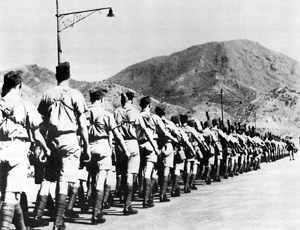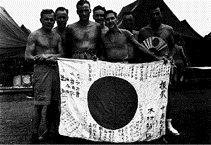Tucked into a corner of the Military Room
of the museum I've been working at this summer in Melita, Manitoba is a World War Two uniform that, at first glance, is very
similar to the other ones that had been donated or loaned to the over the decades. The
khaki uniform by itself is unremarkable, but when you look at the three ribbons
for medals and the patches on the sleeves, another story is told.
Unfortunately, this story is of war, terror and unspeakable atrocities that the
wearer would have gone through. For the name of the unit, in white letters on red is "WINNIPEG GRENADIERS," and below that, a very "Oriental" facsimile of the letters HK, standing for Hong Kong.
 |
| It's amazing all the things you will find in small town museums. |
The Grenadiers was first established in
1908 as the 100th Regiment, with the Headquarters in Morden and the
eight companies in different towns throughout southern Manitoba. In 1910 the
entire regiment was moved and based in Winnipeg, and was renamed the 100th
Winnipeg Grenadiers. In 1920, after World War One, the regiment was finally
renamed as the Winnipeg Grenadiers. While the regiment itself didn’t serve in
World War One due to the establishment of separate battalions for the Canadian Expeditionary Force, the Grenadiers were allowed to “perpetuate,” or preserve
the battle honors and traditions of three battalions from the CEF: the 11th
Battalion, the 78th Battalion (Winnipeg Grenadiers) and the 100th
Battalion (Winnipeg Grenadiers). In 1936, the 10th Machine Gun
Brigade, CMGC (Canadian Machine Gun Corps) was amalgamated with The Winnipeg
Grenadiers, and now the unit was officially The Winnipeg Grenadiers (MG). Other units have been formed and merged and broken away over the years, so to make it easier, here's a picture. If you can't read it, here's the link
 |
| Told you it was complicated... |
When World War Two broke out in September
1939, The Winnipeg Grenadiers was activated for war duty and was renamed First
Battalion, The Winnipeg Grenadiers. A second Battalion was set up to serve as a
reserve force and remained in Winnipeg for the duration of the war. The First
Battalion was sent to Jamaica and Bermuda for garrison duty from May 1940 to
October 1941. But in autumn of 1941, the Canadian government chose the Winnipeg
Grenadiers as part of “C Force,” a small unit of Canadian soldiers offered to
Winston Churchill, Prime Minister of the United Kingdom and one of the most interesting people ever, for the defense of
Hong Kong. C Force also included the Royal Rifles of Canada, originally from
Quebec, though they had only served in garrison duty in Canada. In all, 1,977
soldiers and headquarters personal under the commander of Brigadier John K. Lawson
were sent to Hong Kong on two ships, the troopship Awatea and armored merchant cruiser Prince Robert. With other British, Indian and local Chinese troops,
over 14,000 soldiers were now in place to defend Hong Kong.
 |
| Everything will be fine. Right guys? |
Hong Kong had been a British colony since
1841, captured from the moribund Qing Empire in the First Opium War, and served
as an important trading base with China and Asia for decades. However, with the
end of an alliance between the United Kingdom and the Empire of Japan in the
1920s, British military officials realized that Hong Kong would be nearly
impossible to hold in the face of Japanese attack. These fears only increased
after 1937 with the start of the Japanese invasion of Mainland China, which
lead to the surrounding of Hong Kong.
 |
| British Hong Kong: For all your "Overthrowing Empires with a Highly Addictive Drug" needs! |
When war broke out in Europe in 1939,
Winston Churchill and his military advisors decided to reduce the size of the
garrison of Hong Kong to a “symbolic” size. But in September 1941, that
decision was reversed. It was believed that a fortification of the colony
serving as both a possible deterrent to Japanese aggression and reassurance to
Nationalist China leader Chiang Kai-shek that Britain would support them.
On December 8, 1941, those hopes proved
false. Eight hours after the attack on Pearl Harbor in Hawaii (which happened
on December 7, 1941, as many people I'm sure are going to tell me. However, both events were on opposite sides of the
International Date Line, hence the differences in dates) 52,000 men of the
Japanese Twenty-Third Army invaded Hong Kong with no warning, catching the
British forces unprepared. With only five planes (the closest squadron being
over 2000 kilometres away) and three destroyers, two of which were soon sent to
Singapore. The British were outnumbered 4 to 1, and the Japanese forces had
recent combat experience fighting in China, while most of the British, Indian
and Canadian troops were garrison units with little or no combat experience.
The Battle for Hong Kong lasted 17 days,
during which time the Allied forces were forced from the small enclave on the
mainland to the island of Hong Kong itself, and the defense divided into two
brigades to support the other. The Japanese landing on the island on December
18 was fiercely fought, and the West Brigade under Canadian Brigadier Lawson
were overrun, with Lawson himself losing his life, the most senior Canadian
officer in World War Two to have died in battle. By Christmas Day, 1941, the
remaining British and Commonwealth forces surrendered. Of the 14,000 troops,
2,113 were killed or missing, 2,300 wounded, and 10,000 were captured by the
Japanese.
 |
| Because I can't describe everything that happened... here's a map. |
Only 2000 Japanese soldiers were killed, with 6,000 wounded. One of
those killed was Company Sergeant-Major John Robert Osborn, who was awarded the
Victoria Cross, the highest decoration that can be awarded in the British
Commonwealth, for heroism during the battle. When a grenade was thrown into the
house he and several soldiers were fighting from, Sergeant-Major Osborn shouted
to his comrades to stay down, and he jumped on the grenade, sacrificing himself
to save many others.
Those that were captured faced horrific conditions and treatment at the hand of
the Japanese, who saw the prisoners of war as “subhuman” for not fighting to
the death, and therefore having lost all respect and rights. They were forced
marched and kept in unsanitary, overcrowded conditions for years. Soldiers were
beaten, starved and even killed at the hands of the Japanese soldiers. Japanese
soldiers also massacred hundreds of soldiers and civilians during the battle,
and the populace was subjected to rape, violence, starvation and oppression
until the surrender of Japan in September 1945. Fortunately, the man who wore the uniform donated to the Museum lived to see his home in rural Manitoba after the war.
 |
| I really have nothing funny I can say about the treatment the POW's received... so here's a picture of when they were liberated |
The 1st Battalion, Winnipeg
Grenadiers, was re-established in 1942 and served in Canada as part of the
defense of Canada, before being sent to Alaska and later England as a training
unit for the rest of the war. After the war The Winnipeg Grenadiers served as
part of the active army until February 28, 1965, when it was placed on the
“Supplementary Order of Battle,” meaning that it is virtually disbanded, with
no personal serving under that regiment. However, should the need arise, the
regiment can be reformed and “…it will take its old place in the order of
precedence and its colors, traditions, and battle honors will remain as if
there had been no interruption of service.” So maybe someday The Winnipeg
Grenadiers, the first Canadian military unit to see fighting in World War Two,
will be established again.
No comments:
Post a Comment